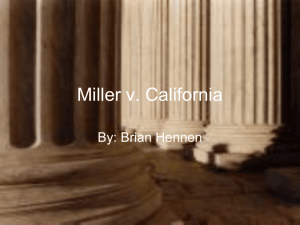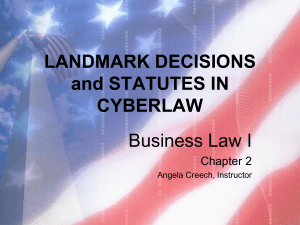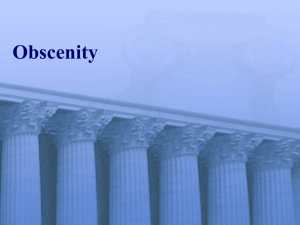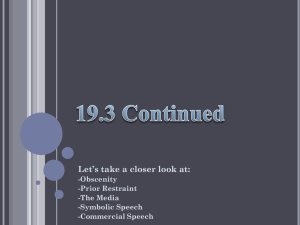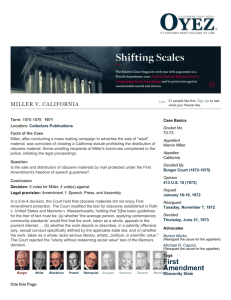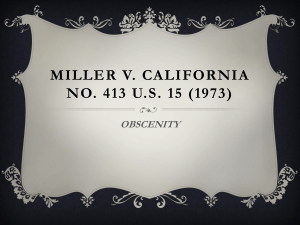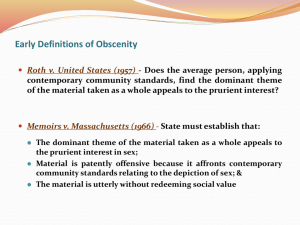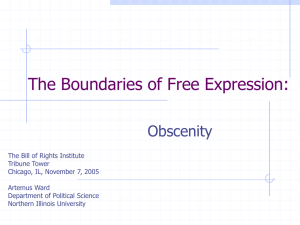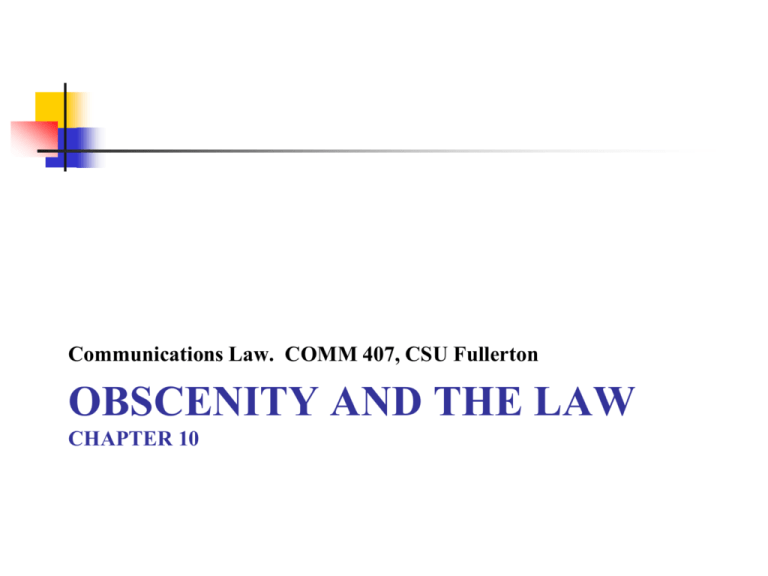
Communications Law. COMM 407, CSU Fullerton
OBSCENITY AND THE LAW
CHAPTER 10
Controlling / Regulating
obscenity, pornography, indecency
FCC regulations of broadcast
Local, state, and federal governments’
restrictions of all media
Definitions
Obscenity: a class of sexual material so offensive
that is deemed by the Supreme Court to have
virtually no 1st Amendment protection
Pornography: all material that is sexually
explicit and intended primarily for the purpose of
sexual arousal
Indecency: not necessarily obscene, but deemed
inappropriate for the airwaves
Historical background
Under the common law rule that prevailed since
the 1868 English case Hicklin v. Regina,
any material that tended to "deprave and corrupt
those whose minds are open to such immoral
influences" was deemed "obscene" and could be
banned on that basis.
The Anti-Obscenity Act of 1873
The Comstock Law
Roth v. United States (1957)
[decided with with Alberts v. California]
Facts of the Case: Roth was convicted of mailing
obscene circulars and an obscene book in violation
of a federal obscenity statute.
Question: Did either the federal or California's
obscenity restrictions, prohibiting the sale or
transfer of obscene materials through the mail,
impinge upon the freedom of expression as
guaranteed by the First Amendment?
Roth v. United States (1957)
Conclusion: The Court held that obscenity
was not "within the area of constitutionally
protected speech or press." The Court noted
that the First Amendment was not intended
to protect every utterance or form of
expression, such as materials that were
"utterly without redeeming social
importance."
Roth test to determine obscenity
"whether to the average person, applying
contemporary community standards, the
dominant theme of the material taken as a
whole appeals to prurient interest."
The Court held that such a definition of
obscenity gave sufficient fair warning and
satisfied the demands of Due Process.
The question of
community v national standards
Jacobellis v. Ohio (1964).
The Court ruled that the Constitution requires
national standards on obscenity.
Stanley v. Georgia (1969)
Facts of the Case
Law enforcement officers searched Stanley's home
pursuant to an investigation of his alleged bookmaking
activities. During the search, the officers found three reels
of eight-millimeter film. It was concluded the films were
obscene. Stanley tried and convicted under a Georgia law
prohibiting the possession of obscene materials.
Question
Did the Georgia statute infringe upon the freedom of
expression protected by the First Amendment?
Stanley v. Georgia (1969)
Decision: 9 votes for Stanley, 0 votes against
The Court held that the First and Fourteenth Amendments
prohibited making private possession of obscene materials
a crime.
The Court distinguished between the mere private
possession of obscene materials and the production and
distribution of such materials. The latter, the Court held,
could be regulated by the states.
Paris Adult Theatre v. Slaton (1973)
Facts of the Case: State officials in Georgia sought to
enjoin the showing of allegedly obscene films at the
Theatre. The Theatre clearly warned potential viewers of
the sexual nature of the films. The Georgia Supreme
Court held that the films were "hard core"
pornography unprotected by the Constitution.
Question: Did the Georgia injunction against the films
violate the First Amendment's guarantee of freedom of
expression?
Paris Adult Theatre v. Slaton (1973)
Conclusion:
The Court held that obscene films did not acquire
constitutional protection simply because they were
exhibited for consenting adults only.
The Court found that there were "legitimate state interests
at stake in stemming the tide of commercialized
obscenity," including the community's quality of life and
public safety.
Miller v California (1973)
Facts of the Case: Miller was convicted of
violating a California statute prohibiting the
distribution of obscene material. Some unwilling
recipients of Miller's brochures complained to the
police, initiating the legal proceedings.
Question: Is the sale and distribution of obscene
materials by mail protected under the First
Amendment's freedom of speech guarantee?
Miller v California (1973)
Conclusion:
In a 5-to-4 decision, the Court held that obscene
materials did not enjoy First Amendment
protection. The Court modified the test for
obscenity established in Roth v. United States
The Miller Test (modified Roth)
1. The average person, applying contemporary
community standards would find that the work,
taken as a whole, appeals to the prurient interest
2. The work depicts or describes, in a patently
offensive way, sexual conduct specifically defined
by the applicable state law
3. The work, taken as a whole, lacks serious
literary, artistic, political, or scientific value.
Return to the community standard
Chief Justice Warren Burger:
“It is neither realistic nor constitutionally necessary to read
the First Amendment as requiring that the people of Maine
or Mississippi accept public depiction of conduct found
tolerable in Las Vegas, or New York City.”
The work, taken as a whole, appeals to
the prurient interest
Prurient: having or encouraging unhealthy
sexual curiosity. The material was intended to
lewd, lustful, shameful, or morbid thoughts about
sex
Normal, healthy sexual desire does not fall into
this category
BUT: What is lustful and what is healthy and
normal?
Patent (obvious) offensiveness
Patently offensive representations or depictions of
ultimate sexual acts, normal or perverted, actual or
simulated
Patently offensive representations or descriptions
of masturbation, excretory functions, and lewd
exhibition of the genitals
Lack of serious value
A national, reasonable-person standard is used
(not a community standard).
Pope v. Illinois (1987)
Facts of the Case:
Two employees of an adult bookstore were charged of the
offense of ‘‘obscenity’’ under Illinois law after they sold
magazines to police detectives. At their trials, the judges
instructed the juries to determine the value of the
magazines based on how they thought ‘‘ordinary adults
in the whole State of Illinois’’ would view them.
The defendants argued Miller’s value question should be
judged ‘‘solely on an objective basis,’’ which the trial
courts and state appellate courts rejected.
Pope v. Illinois (1987)
The Question:
The three-part test for judging if sexually explicit material
is obscene as enunciated in Miller v. California (1973),
required an assessment of ‘‘whether the work, taken as a
whole, lacks serious literary, artistic, political, or scientific
value.’’
The question is whether judges could instruct juries to use
community standards when they decided this ‘‘value
question.’’
Pope v. Illinois (1987)
The Conclusion:
The Supreme Court vacated Pope’s conviction and
remanded the case to the state courts for reconsideration.
The Court stressed that the majority opinion in Miller was
‘‘careful to point out’’ that the First Amendment protects
works of serious value ‘‘regardless of whether the
government or a majority of the people approve of the
ideas these works represent.’’
Pope v. Illinois (1987)
The value of such work, moreover, does not vary from
community to community according to whether or to what
degree the work wins public acceptance.
Justice White concluded that the ‘‘proper inquiry,’’
contrary to the approach taken in Illinois, did not rest on
how ‘‘ordinary members’’ of a particular community view
the social value of an allegedly obscene work; rather it
depended on whether a ‘‘reasonable person,’’ using by
implication a national standard, found social value in the
work taken as a whole
Contemporary Arts Center in Cincinnati,
Ohio: Robert Mapplethorpe Show
Dennis Barrie and the
Contemporary Arts Center were
indicted for pandering
obscenity hours after the
opening of the show that
exhibited several portraits,
mostly of sadomasochistic acts.
Mr. Barrie and the
arts center he directed
were acquitted in a muchpublicized trial that lasted
six months.
Protesters outside the
Contemporary Arts Center
Pornography and Minors
The Supreme Court generally agreed that
“the need to control child pornography was so
“compelling” that the states were free to enact laws that
might be unconstitutional under other circumstances.”
Osborne v. Ohio (1990)
Also New York v. Ferber (1982)
The PROTECT Act of 2003
Upheld in U.S. v. Williams (2008)
Local, State, and Federal
Obscenity Laws
All states have laws governing the distribution
of obscene materials.
Generally, these statutes prohibit the sale, lending,
renting, giving, publication, exhibition or other
dissemination of materials, with general
knowledge of their obscene character and content.
Municipal Laws / Regulations
Nuisance Laws: declaring an adult-oriented
business a public nuisance
Women’s Rights and Pornography: declaring
that pornography violates the civil rights of
women
Zoning
Full Exclusion

